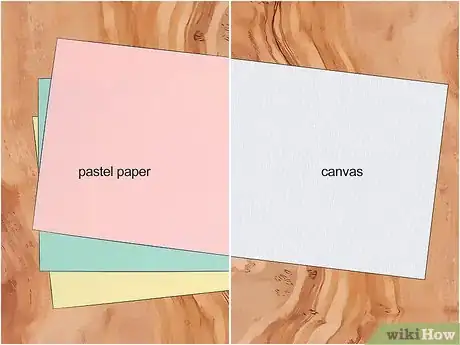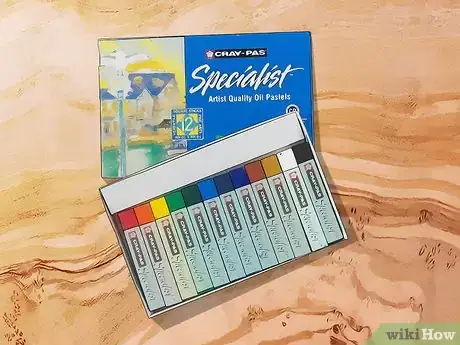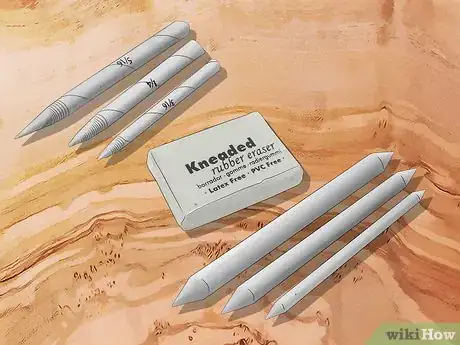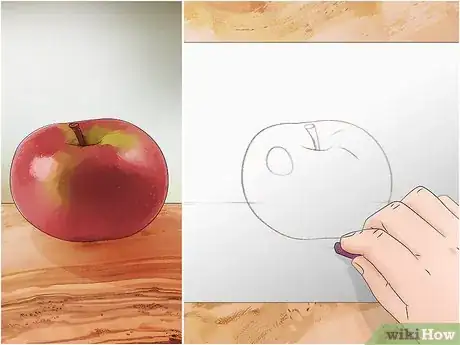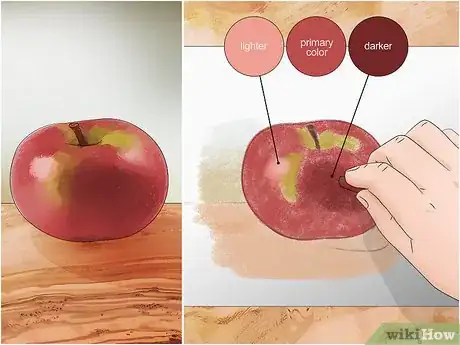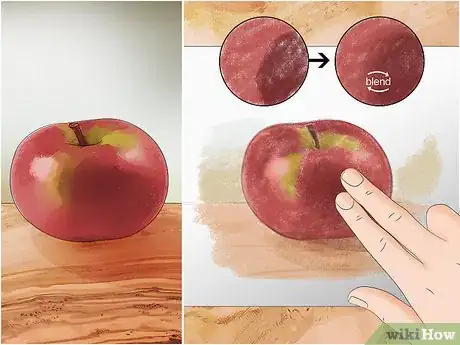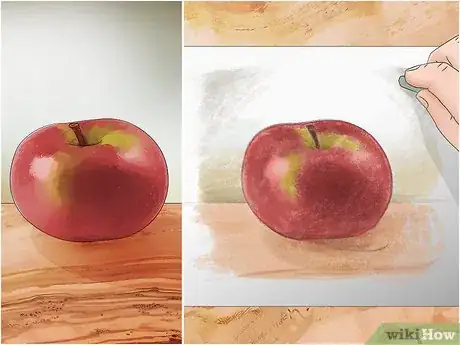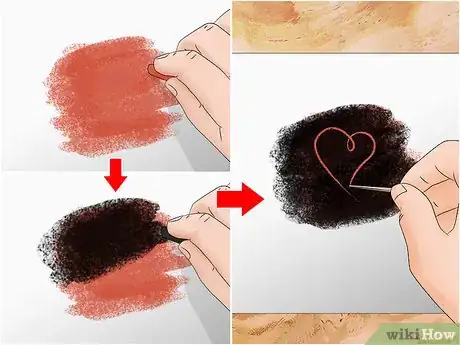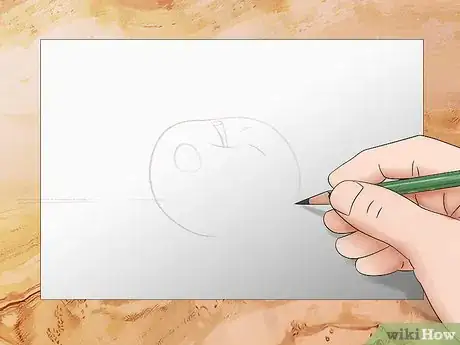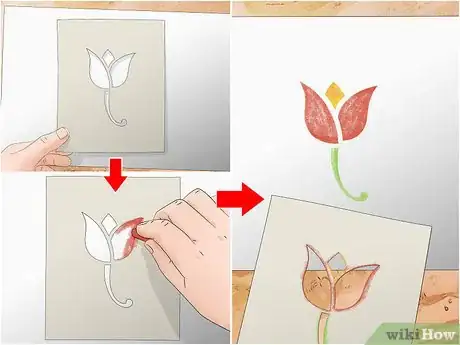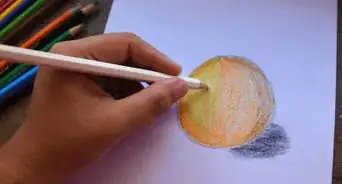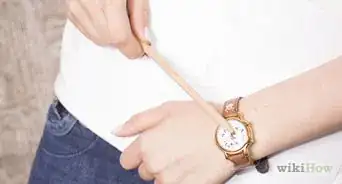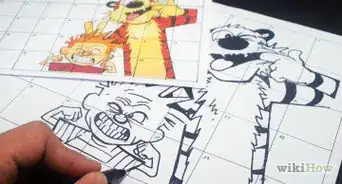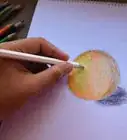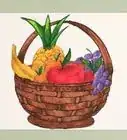This article was co-authored by Kelly Medford. Kelly Medford is an American painter based in Rome, Italy. She studied classical painting, drawing and printmaking both in the U.S. and in Italy. She works primarily en plein air on the streets of Rome, and also travels for private international collectors on commission. She founded Sketching Rome Tours in 2012 where she teaches sketchbook journaling to visitors of Rome. Kelly is a graduate of the Florence Academy of Art.
wikiHow marks an article as reader-approved once it receives enough positive feedback. This article has 11 testimonials from our readers, earning it our reader-approved status.
This article has been viewed 558,488 times.
Drawing with oil pastels is a fun activity that combines the characteristics of wax crayons and pastels. And while the end result can be beautiful, oil pastels are a bit more difficult to use and blend than standard types. Of course, with the right materials, proper technique, and a bit of effort, you can learn how to create your own beautiful oil pastel paintings.
Steps
Gathering the Necessary Materials
-
1Select pastel paper, watercolor paper, sand board, or canvas. Each of these mediums has enough tooth or texture to ensure that pastels adhere. For lighter sketch-like drawings, select papers with 90 gsm thickness. If you want to create something with a bolder palette, choose papers with 160 gsm thickness. A smooth paper will not properly stick to your pastels. Always choose a paper size that will fit your subject without leaving too much or too little space.[1]
- Don't use papers that contain acids, as they will lead to color shifting and brittleness.
- Use paper colors similar to your pastel colors to create a unifying, harmonious vibe. For example, choose a light-green pastel paper for a nature setting with lots of green shades.
- To experiment with different moods and atmospheres, select paper colors that contrast with your pastel colors. For example, if you're drawing a blue lake with a black night sky, choose a purple paper for a melancholy effect.
-
2Purchase a pastel set from a trusted brand with the colors you desire. Unlike other kinds of pastels, oil pastels are not offered by a variety of manufacturers—there are only a few that offer artist-level brands. For beginners, Van Gogh Extra-Fine Artist Oil Pastels are student-grade but with a degree of quality that is competitive with artist-grade brands. For artist-grade brands, try out the cheapest set or put together the palette of your choosing from the open stock selection.[2]
- Think about the kind of pictures you want to create and select colors to suit your ideas. Choose from open stock colors and put together a nice palette.
- Pastels can be purchased from art stores, online suppliers, and big-box stores.
Advertisement -
3Choose a mix of hard and soft pastels for the most flexibility. Harder brands are best for finer details like outlines and early layers, while softer brands are best for drawing over heavy, saturated layers of firm pastel. Artist-grade brands in order of hardest to softest are: Cray-Pas Specialist, Cretacolor Aqua Stic, Erengi Art Aspirer, Caran d’Ache Neopastel and Holbein, and Sennelier Oil Pastels.
- Take note of the brands you're most comfortable drawing with as you get more experience.
-
4Buy some accessories like brushes, erasers, and blending tools. Brushes and sponges are ideal for smudging your oil pastels. For erasing, buy a kneaded eraser, which is also known as putty rubber. Pick up some tortillons, which are cylindrical drawing tools that are ideal for blending and smudging, and blending stumps, which are similar to tortillons but tighter wrapped, longer, and pointed at the ends.[3]
- Scratching tools can be swapped with toothpicks (wood or plastic) or nail cleaning knives.
Practicing General Techniques
-
1Choose a subject to draw and decide how large you want it to be. Start with an easy subject like a dog, a house, a lake, or a simple object like an apple. If you're up for a challenge, you can choose something harder, like a person or landscape.[4]
- Consider all the oil pastel colors you have when deciding on your image and make sure you have the colors that you need. If you're missing a couple, see if you can improvise.
- Begin with images that contain just 1 to 3 colors. Within these colors, you can create different shades, so you'll still have plenty to work with.
-
2Draw a rough sketch on a test paper to plan your image. On the test sheet, which should be identical to your chosen pastel paper, draw something small and simple using a pastel. Be sure to apply just a light amount of pressure. Don't draw too many details – focus on getting your outline and getting a feel for the paper. Continue practicing until you're happy with your rough sketch.
- Label regions of your image with your planned colors. For example, label the ground dark green, and mark specific patches dark blue for puddles of water.
-
3Sketch a light outline on the main paper with a hard, colored pastel. Select a lighter color and gently draw your outline by applying a small amount of pressure. If you make a mistake, erase it and try again. Don't worry about the finer details yet—save those for later.[5]
- Don't use black for your outline to avoid contaminating the other colors.
- Create vertical and horizontal lines of symmetry to split up larger objects and shapes. This will help you place your colors and blend them properly.
- Use harder pastels for your outline to allow for greater accuracy.
-
4Work from the background to the foreground. When working with pastels, it's better to work from the background to the nearest object. Using this principle, you're always drawing object edges over the background, which makes for better accuracy. After filling in your background and foreground, blend the colors together using your fingers or a tissue.[6]
- Use thick layers of pastel for your background layers by applying a modest amount of pressure as you color them in. If you plan to draw over these layers, use a lighter amount of pressure.
- Stick to harder pastel brands for backgrounds and bottom layers. For the foreground and additional layers, use lighter pastel brands.
-
5Draw a rough underpainting of the main objects with the primary color. An important part of drawing with pastels is the base layer. For example, if you're drawing a pear, draw over your outline in a medium green color. Afterward, begin coloring it in with this same shade of green. Always apply a generous amount of pressure when creating your base layer.[7]
- Save the extreme colors—in this case, light green or dark green—for later.
- Smudge the primary color into the outline using a blending tool for a more seamless transition.
-
6Add additional colors to your drawing as the second layers. Start adding more details and colors to your object. If you're drawing a pear and just added a darker green, you can start applying another darker green to one side of the pear and a light green to the other. Use less pressure for these layers.[8]
- Blend your colors with your finger or a tissue.
- Utilize your symmetry lines to separate colors and blend them at the point they meet.
-
7Blend different colors to create a sense of flow in your images. Always start with the darker color first when blending. Apply firm pressure to the tip of the pastel and slowly decrease pressure as you work your way into a specific direction. After adding the first color, begin drawing another color next to it in the light spot of the first color. Now, using a paper stub or your fingers, gently rub the colors together. This will smooth the edges that divide the colors and create a blending effect.[9]
- Soak a cotton swab in baby oil and drag it along your drawings to blend your colors without using your fingers.
- Use blending tools like tortillons and blending stumps for the most control and accuracy. These are ideal for blending smaller areas.
- Swirl your strokes when blending to vary the effect.
-
8Continue filling in your objects and layering colors. Use all of the basic pastel techniques that you can find a place for. For example, layer a dark blue on top of a light blue for a puddle. Afterward, scratch off regions of the top layer to reveal the bottom and create a unique water effect.[10]
- Don't add too many colors too fast—this can muddy them. Practice restraint and if something looks good, don't add anything else!
- Use softer pastels when adding layers to make blending easier.
- Stick to harder pastels when you're working with finer details, such as a pear stem or the leaves of a tree.
-
9Keep practicing and don't overextend yourself! You're not going to make a perfect picture right away. Take it slow and keep experimenting with different shapes, images, colors, and textures. Remember that this was your first attempt and that everyone needs practice to do something well.[11]
- Try out different kinds of scenes and objects to build your skills.
- Purchase different kinds of pastel colors and experiment with unique combinations.
-
10Seal your image with an oil pastel fixative when you're done. Always apply the fixative with light sprays in a well-ventilated area. After letting the fixative dry for about 10 minutes, you can leave the artwork be or frame it. Be sure to use a thick mat to ensure the artwork is about a 3⁄16 inch (0.48 cm) distance away from the glass so it doesn't smudge.[12]
- Mount the picture onto a wooden panel prior to framing for the most protection.
Learning Advanced Techniques
-
1Overlay multiple colors to create dynamic images. Start by applying a base color to your paper using firm pressure. Now, layer the second color over the base using the broad side of your pastel. For example, if you're drawing a sun, draw a layer of yellow as your base. Afterward, apply a layer of red over half or all of the yellow to create a unique orange-red mix.[13]
- Experiment with various pressures as you add your layers. For example, make the first layer of your sun a mild yellow by applying it with light pressure. Now, add some light layers of orange and red to create different hues.
-
2Scratch varying and layered colors for unique exposure. After creating 2 thick overlays of different colors, scratch line designs on the top layer with a painting knife, comb, or needle to reveal the bottom. This technique works best when the final layer is a dark color, such as gray or black.[14]
- Use this technique to add line colors to your final design. For example, if you created a pear design with a final layer of dark green, scratch lines to reveal the lighter green beneath it.
- Experiment with various kinds of tools, such as a paperclip or toothpick, to create different kinds of revealing effects.
- Layer 3 to 4 colors to reveal more by scratching.
-
3Draw outlines in pencil or light oil pastel for guidance. Once you're comfortable with basic blending, start drawing some images to work with. Start simple and draw outlines first. Try simple objects like a sun, tree, or apple. Try your first sketches in pencil. Once you get more comfortable, start drawing outlines in oil pastel. When outlining in pastel, remember to apply a light amount of pressure and draw with the tip—not the broad side.[15]
- Break complex objects into shapes like circles, squares, and triangles.
- Don't use black for your outline, as it will ruin the purity of colors applied over it.
-
4Cut out a stencil to create thick image patterns and drop-out images. Draw an image on a piece of paper, such as a flower. Cut out the image and place the stencil on your pastel paper. Now, color along the edges of the stencil to create a thick image outline just outside of its outer edge. Alternatively, place the shape you cut from the stencil onto your pastel paper and color over the edges to create a drop-out image.[16]
- When creating a drop-out image, rub your fingers from the edges inward to create soft hues.
Expert Q&A
-
QuestionWhat is used to blend oil pastels?
 Kelly MedfordKelly Medford is an American painter based in Rome, Italy. She studied classical painting, drawing and printmaking both in the U.S. and in Italy. She works primarily en plein air on the streets of Rome, and also travels for private international collectors on commission. She founded Sketching Rome Tours in 2012 where she teaches sketchbook journaling to visitors of Rome. Kelly is a graduate of the Florence Academy of Art.
Kelly MedfordKelly Medford is an American painter based in Rome, Italy. She studied classical painting, drawing and printmaking both in the U.S. and in Italy. She works primarily en plein air on the streets of Rome, and also travels for private international collectors on commission. She founded Sketching Rome Tours in 2012 where she teaches sketchbook journaling to visitors of Rome. Kelly is a graduate of the Florence Academy of Art.
Professional Artist You can use turpentine or other plant-based oils like walnut, linseed, or sunflower oil for a smoother transition. Just put a little oil on a cotton swab, Q-tip, or cloth and rub it along the drawing.
You can use turpentine or other plant-based oils like walnut, linseed, or sunflower oil for a smoother transition. Just put a little oil on a cotton swab, Q-tip, or cloth and rub it along the drawing. -
QuestionAre Camel oil pastels okay if they only have twelve shades?
 Community AnswerYes, because if you want more than twelve shades, you can make them by mixing colors. Just apply one color on top of another one and blend.
Community AnswerYes, because if you want more than twelve shades, you can make them by mixing colors. Just apply one color on top of another one and blend. -
QuestionCan you blend the colors with cotton?
 Community AnswerYes, you can blend the colors with cotton.
Community AnswerYes, you can blend the colors with cotton.
Things You'll Need
- Oil Pastels
- Paper
- Pencil
- Blending stub (optional)
- Mop-haired brush (optional)
Warnings
- Leave your art to dry for an hour before touching it.⧼thumbs_response⧽
References
- ↑ https://www.artistsandillustrators.co.uk/how-to/Pastels/672/how-to-choose-pastel-grounds
- ↑ http://emptyeasel.com/2009/01/22/oil-pastels-101-a-comprehensive-guide-to-painting-with-oil-pastel/
- ↑ http://emptyeasel.com/2009/01/22/oil-pastels-101-a-comprehensive-guide-to-painting-with-oil-pastel/
- ↑ https://www.creativebloq.com/art/how-start-pastel-drawing-21619146
- ↑ http://www.artyfactory.com/still-life/still_life_oil_pastel.html
- ↑ http://www.artyfactory.com/still-life/still_life_oil_pastel.html
- ↑ http://www.artyfactory.com/still-life/still_life_oil_pastel.html
- ↑ http://www.artyfactory.com/still-life/still_life_oil_pastel.html
- ↑ https://youtu.be/jm6wo-8rJD0?t=1m44s
- ↑ http://www.artyfactory.com/still-life/still_life_oil_pastel.html
- ↑ http://www.artyfactory.com/still-life/still_life_oil_pastel.html
- ↑ http://www.artyfactory.com/still-life/still_life_oil_pastel.html
- ↑ https://sakuraofamerica.com/free-downloads/content-page/cray-pas-instructions
- ↑ https://sakuraofamerica.com/free-downloads/content-page/cray-pas-instructions
- ↑ http://www.artyfactory.com/still-life/still_life_oil_pastel.html
- ↑ https://sakuraofamerica.com/free-downloads/content-page/cray-pas-instructions
About This Article
Drawing with oil pastels is a little harder than regular pastels, but it just takes a little practice. Start with pastel paper, canvas, or watercolor paper, then choose a light-colored pastel crayon and sketch the outline of your drawing. As you start filling in detail, start by creating the background, then work forward. To draw your main objects, choose a base color, then outline and color in the object in that color. Add detail by using lighter and darker colors over the base color, blending the colors with your finger or a tissue. Keep reading to learn how to seal your image with fixative when you’re finished!
